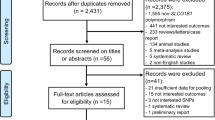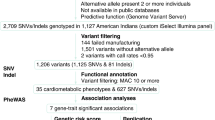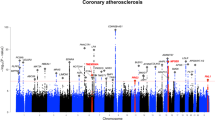Abstract
Replying to D. F. Carr et al. Nature 513, 10.1038/nature13628 (2014); J. S. Floyd et al. Nature 513, 10.1038/nature13629 (2014)
Our study1 tested for associations of single-nucleotide polymorphisms (SNPs) at the GATM loci with statin-induced myopathy based on the finding that one of these SNPs (rs986699) was associated with statin-induced expression of GATM in a panel of human lymphoblastoid cell lines, and the fact that GATM encodes the enzyme responsible for synthesis of creatine, a major source of energy in skeletal muscle1. Significant associations with incidence of myopathy were found for rs9806699 in statin users from the Marshfield Clinic cohort. Furthermore, significant association was reported in both the Marshfield cohort and in the SEARCH clinical trial of simvastatin treatment for two SNPs in linkage disequilibrium with the index SNP (rs1719247 and rs1346268, r2 > 0.7) that were genotyped in each of these groups. We have extended our meta-analysis to include the study data reported in the accompanying Comments by Carr et al.2 and Floyd et al.3, two studies that individually failed to replicate this association.
Similar content being viewed by others
Main
The original analysis was performed on data from patients who were not on fibrates in the Marshfield and SEARCH populations. This was done to mitigate the risk that a possible modest protective effect of the SNPs would be masked by the known pharmacokinetic confounding caused by concomitant use of fibrates or other drugs that promote myopathy by altering statin pharmacokinetics4. We have done the same for the results of Floyd et al. in the meta-analyses presented below, although it is notable that, based on clinical presentation and creatine kinase levels, the majority of the myopathy cases of Floyd et al. were considerably more severe than in the originally reported cohorts5. This analytical approach was not possible for the study of Carr et al., since data for this subgroup were not provided. In this regard we note that because pharmacokinetic effects are major determinants of statin toxicity, the confirmation by both Carr et al. and Floyd et al. of an association of myopathy with a functional variant of the transporter gene SLC01B1 is not representative of the power of their analyses to detect a SNP association with a modest pharmacodynamic effect.
A fixed-effects meta-analysis yielded the following P values: rs9806699 (Marshfield, Carr et al. and Floyd et al.), P = 0.085; rs1719247 (Marshfield, SEARCH and Floyd et al.), P = 0.0042; rs1346268 (Marshfield, SEARCH and Floyd et al.), P = 0.0035. Thus, the statistical significance of the initially reported association is weakened but not eliminated by the inclusion of the additional cohorts. Future efforts to replicate these findings should give consideration to heterogeneity of patient characteristics, matching of statin exposure in cases and controls, avoidance of concomitant drug use and other confounding factors, and the statistical power to detect an association of modest effect size. We agree with Carr et al. that the association should be assessed in more patients and hope that a larger meta-analysis will be performed. In addition, further studies will be required to determine a mechanistic basis for a contribution of GATM genetic variation to the risk of statin-related myopathy. This Reply is written by the subset of authors that designed and led these analyses.
References
Mangravite, L. M. et al. A statin-dependent QTL for GATM expression is associated with statin-induced myopathy. Nature 502, 377–380 (2013)
Carr, D. F. et al. GATM gene variants and statin myopathy risk. Nature 513, http://dx.doi.org/10.1038/nature13628 (2014)
Floyd, J. S. et al. GATM locus does not replicate in rhabdomyolysis study. Nature 513, http://dx.doi.org/10.1038/nature13629 (2014)
Graham, D. J. et al. Incidence of hospitalized rhabdomyolysis in patients treated with lipid-lowering drugs. J. Am. Med. Assoc. 292, 2585–2590 (2004)
Marciante, K. D. et al. Cerivastatin, genetic variants, and the risk of rhabdomyolysis. Pharmacogenet. Genomics 21, 280–288 (2011)
Author information
Authors and Affiliations
Corresponding author
Rights and permissions
About this article
Cite this article
Mangravite, L., Engelhardt, B., Stephens, M. et al. Mangravite et al. reply. Nature 513, E3 (2014). https://doi.org/10.1038/nature13630
Published:
Issue Date:
DOI: https://doi.org/10.1038/nature13630
This article is cited by
Comments
By submitting a comment you agree to abide by our Terms and Community Guidelines. If you find something abusive or that does not comply with our terms or guidelines please flag it as inappropriate.



